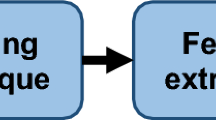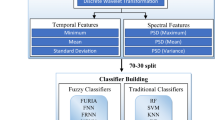Abstract
Listening via stethoscope is a preferential method, being used by physicians for distinguishing normal and abnormal cardiac systems. On the other hand, listening with stethoscope has a number of constraints. The interpretation of various heart sounds depends on physician’s ability of hearing, experience, and skill. Such limitations may be reduced by developing biomedical-based decision support systems. In this study, a biomedical-based decision support system was developed for the classification of heart sound signals, obtained from 120 subjects with normal, pulmonary, and mitral stenosis heart valve diseases via stethoscope. Developed system comprises of three stages. In the first stage, for feature extraction, obtained heart sound signals were separated to its sub-bands using discrete wavelet transform (DWT). In the second stage, entropy of each sub-band was calculated using Shannon entropy algorithm to reduce the dimensionality of the feature vectors via DWT. In the third stage, the reduced features of three types of heart sound signals were used as input patterns of the adaptive neuro-fuzzy inference system (ANFIS) classifiers. Developed method reached 98.33% classification accuracy, and it was showed that purposed method is effective for detection of heart valve diseases.








Similar content being viewed by others
References
Jiang Z, Choi S (2006) A cardiac sound characteristic waveform method for in-home heart disorder monitoring with electric stethoscope. Exp Syst Appl 31(2):286–298
Ahlström C (2006) Processing of the phonocardiographic signal-methods for the intelligent stethoscope. Ms thesis, Linköping University, Institute of Technology, Linköping, Sweden
Kara S (2007) Classification of mitral stenosis from Doppler signals using short time Fourier transform and artificial neural Networks. Exp Syst Appl 33:468–475
Güraksın GE, Ergün U, Deperlioğlu Ö (2009) Classification of the heart sounds via artificial neural network. International symposium on innovations in intelligent systems and applications, pp 507–511
Say Ö (2002) Analysis of heart sounds and classification of by using artificial neural networks. Ms thesis, Institute of Natural and Applied Science, İstanbul Technical University, İstanbul, Turkey
Leung TS, White PR, Collis WB, Brown E, Salmon AP (2006) Classification of heart sounds using time-frequency method and artificial neural networks. Proceedings of the 22nd annual international conference of the IEEE engineering in medicine and biology society, vol 2, pp 988–991
Sinha RK (2003) Artificial neural network detects changes in electro-encephalogram power spectrum of different sleep-wake states in an animal model of heat stress. Med Biol Eng Comput 41:595–600
Kandaswamy A, Kumar C, Ramanathan R, Jayaraman S, Malmurugan N (2004) Neural classification of lung sounds using wavelet coefficients. Comput Biol Med 34(6):523–537
O’Rourke RA (2000) Cardiovascular disease: foreword. Curr Probl Cardiol 25(11):786–825
Maglogiannis I, Loukis E, Zafiropoulos E, Stasis A (2009) Support vectors machine-based identification of heart valve diseases using heart sounds. Comput Methods Programs Biomed 95:47–61
El-Segaier M, Lilja O, Lukkarinen S, Sörnmo L, Sepponen R, Pesonen E (2005) Computer-based detection and analysis of heart sound and murmur. Ann Biomed Eng 33(7):937–942
Voss A, Mix A, Huebner T (2005) Diagnosing aortic valve stenosis by parameter extraction of heart sound signals. Ann Biomed Eng 33:1167–1174
Folland R, Hines EL, Boilot P, Morgan D (2002) Classifying coronary dysfunction using neural networks through cardiovascular auscultation. Med Biol Eng Comput 40:339–343
Chauhan S, Wang P, Lim CS, Anantharaman V (2008) A Computer Aided MFCC based HMM system for automatic auscultation. Comput Biol Med 38(2):221–233
Sinha RK, Aggarwal Y, Das BN (2007) Backpropagation artificial neural network classifier to detect changes in heart sound due to mitral valve regurgitation. J Med Syst 31:205–209
Hebden JE, Torry JN (1997) Identification of aortic stenosis and mitral regurgitation by heart sound analysis. Comput Cardiol 24:109–112
Ahlstrom C, Hult P, Rask P, Karlsson JE, Nylander E, Dahlstrom U, Ask P (2006) Feature extraction for systolic heart murmur classification. Ann Biomed Eng 34:1666–1677
Pavlopoulos S, Stasis A, Loukis E (2004) A decision tree-based method for the differential diagnosis of aortic stenosis from mitral regurgitation using heart sounds. Biomed Eng OnLine (June 3):1–5
Turkoglu I, Arslan A, Ilkay E (2002) An expert system for diagnosis of the heart valve diseases. Exp Syst Appl 23:229–236
Bhatikar SR, DeGroff C, Mahajan RL (2005) Classifier based on the artificial neural network approach for cardiologic auscultation in pediatrics. Artif Intell Med 33:251–260
Marcianesi A, Scaletti S, Speciale N (2001) A new wavelet-based algorithm for filtering low SRN signals. Neural networks for signal processing XI, proceedings of the IEEE signal processing society workshop, pp 549–558
Graps A (1995) An introduction to wavelets. IEEE Comput Sci Eng 2(2):50–61
Wu J-D, Kuo J-M (2009) An automotive generator fault diagnosis system using discrete wavelet transform and artificial neural network. Exp Syst Appl 36(6):9776–9783
Güler İ, Übeyli ED (2005) ECG beat classifier designed by combined neural network model. Pattern Recognit 38:199–208
Bruni V, Vitulano D (2007) Combined image compression and denoising using wavelets. Signal Process Image Commun 22(1):86–101
Chen J, Zhang Y, Shi X (2006) Image coding based on wavelet transform and uniform scalar dead zone quantizer. Signal Process Image Commun 21(7):562–572
Wu J-D, Hsu C-C (2009) Fault gear identification using vibration signal with discrete wavelet transform technique and fuzzy–logic inference. Exp Syst Appl 36(2):3785–3794
Ekici S, Yildirim S, Poyraz M (2008) Energy and entropy-based feature extraction for location fault on transmission lines by using neural network and wavelet packet decomposition. Exp Syst Appl 34:2937–2944
Gaing XL (2004) Wavelet-based neural network for power disturbance recognition and classification. IEEE Trans Power Deliv 19:1560–1568
Turkoglu I, Arslan A, Ilkay E (2003) An intelligent system for diagnosis of the heart valve diseases with wavelet packet neural networks. Comput Biol Med 33:319–331
Übeyli ED (2009) Combined neural network model employing wavelet coefficients for EEG signals classification. Digital Signal Process 19(2):297–308
Babaei S, Geranmayeh A (2009) Heart sound reproduction based on neural network classification of cardiac valve disorders using wavelet transforms of PCGs signal. Comput Biol Med 39(1):8–15
Subasi A (2007) EEG signal classification using wavelet feature extraction and a mixture of expert model. Exp Syst Appl 32(4):1084–1093
Zadeh LA (1965) Fuzzy sets. Inform Control 8:65–70
Geethanjali M, Mary S, Slochanal R (2008) A combined adaptive network and fuzzy inference system (ANFIS) approach for overcurrent relay system. Neurocomputing 71:895–903
Subasi A, Yilmaz AS, Binici H (2009) Prediction of early heat of hydration of plain and blended cements using neuro-fuzzy modelling techniques. Exp Syst Appl 36:4940–4950
Jang JSR (1993) ANFIS: Adaptive network based fuzzy inference system, IEEE transactions on systems. Man Cybern 23(3):665–683
Güler I, Übeyli ED (2004) Application of adaptive neuro-fuzzy inference system for detection of electrocardiographic changes in patients with partial epilepsy using feature extraction. Exp Syst Appl 27:323–330
Übeyli ED, Güler I (2005) Adaptive neuro-fuzzy inference systems for analysis of internal carotid arterial Doppler signals. Comput Biol Med 35:687–702
Aznarte MJL, Sánchez JMB, Lugilde DN, Fernández CDL, Guardia CDD, Sánchez FA (2007) Forecasting airborne pollen concentration time series with neural and neuro-fuzzy models. Exp Syst Appl 32(4):1218–1225
Atsalakis GS, Valavanis KP (2009) Forecasting stock market short-term trends using a neuro-fuzzy based methodology. Exp Syst Appl 36:10696–10707
Ozturk A, Arslan A, Hardalac F (2008) Comparison of neuro-fuzzy systems for classification of transcranial doppler signals with their chaotic invariant measures. Exp Syst Appl 34(2):1044–1055
Sengur A (2008) Wavelet transform and adaptive neuro-fuzzy inference system for color texture classification. Exp Syst Appl 34(3):2120–2128
Elmas C, Ustun O, Sayan HH (2008) A neuro-fuzzy controller for speed control of a permanent magnet synchronous motor drive. Exp Syst Appl 34(1):657–664
Vieira J, Dias FM, Mota A (2004) Artificial neural networks and neuro-fuzzy systems for modelling and controlling real systems: a comparative study. Eng Appl Artif Intell 17:265–273
Aguilar L, Melin P, Castillo O (2003) Intelligent control of a stepping motor drive using a hybrid neuro-fuzzy ANFIS approach. Appl Soft Comput 3:209–219
Avci E, Hanbay D, Varol A (2007) An expert discrete wavelet adaptive network based fuzzy inference system for digital modulation recognition. Exp Syst Appl 33(3):582–589
Lei Y, He Z, Zi Y, Hu Q (2007) Fault diagnosis of rotating machinery based on multiple ANFIS combination with gas. Mech Syst Signal Process 21:2280–2294
Polat K, Gunes S (2007) Automatic determination of diseases related to lymph system from lymphography data using principles component analysis (PCA), fuzzy weighting pre-processing and ANFIS. Exp Syst Appl 33(3):1636–1664
Übeyli ED (2008) Adaptive neuro-fuzzy inference system employing wavelet coefficients for detection of ophthalmic arterial disorders. Exp Syst Appl 34:2201–2209
Übeyli ED (2009) Adaptive neuro-fuzzy inference system for classification of ECG signals using Lyapunov exponents. Comput Methods Progr Biomed 9(3):313–321
Belal SY, Taktak AFG, Nevill AJ, Spencer SA, Roden D, Bevan S (2002) Automatic detection of distorted plethysmogram pulses in neonates and paediatric patients using an adaptive-network based fuzzy inference system. Artif Intell Med 24:149–165
Uğuz H (2010) A biomedical system based on artificial neural network and principal component analysis for diagnosis of the heart valve diseases. J Med Syst. doi:10.1007/s10916-010-9446-7 (in press)
Güraksın GE (2009) Classification of the heart sounds via artificial neural network. Ms thesis, Institute of Natural and Applied Science, Afyon Kocatepe University, Afyonkarahisar, Turkey
Ocak H (2009) Automatic detection of epileptic seizures in EEG using discrete wavelet transform and approximate entropy. Exp Syst Appl 36:2027–2036
Purushotham V, Narayanan S, Parasad SAN (2005) Multi-fault diagnosis of rolling bearing elements using wavelet analysis and hidden Markov model based fault recognition. NDT&E International 38:654–666
Rioul O, Vetterli M (1991) Wavelets and signal processing. IEEE Signal Process Mag 8(4):14–38
Mallat SG (1989) A theory for multiresolution signal decomposition: the wavelet representation. IEEE Trans Pattern Anal Mach Intell 11(7):674–693
Misiti M, Misiti Y, Oppenheim G, Poggi J (2004) User guide wavelet toolbox for use with MATLAB
Tong S, Bezerianos A, Paul J, Zhu Y, Thakor N (2002) Nonextensive entropy measure of EEG following brain injury from cardiac arrest. Phys A Stat Mech Appl 305(3–4):619–628
Principe JC, Euliano NR, Lefebvre WC (2000) Neural and adaptive systems. Wiley, New York
Shannon CE (1948) A mathematical theory of communication. Bell Syst Tech J 27:623–656
Zhang XS, Roy RJ (2001) Derived fuzzy knowledge model for estimating the depth of anesthesia. IEEE Trans Biomed Eng 48(3):312–323
Kannathal N, Choo ML, Acharya UR, Sadasivan PK (2005) Entropies for detection of epilepsy in EEG. Comput Methods Progr Biomed 80:187–194
Yildiz A, Akin M, Poyraz M, Kirbas G (2009) Application of adaptive neuro-fuzzy inference system for vigilance level estimation by using wavelet-entropy feature extraction. Exp Syst Appl 36:7390–7399
Kulkarni AD (2001) Computer vision and fuzzy neural systems. Prentice-Hall, Englewood Cliffs
Baylar A, Hanbay D, Ozpolat E (2008) An expert system for predicting aeration performance of weirs by using ANFIS. Exp Syst Appl 35:1214–1222
Kiymik MK, Akin M, Subasi A (2004) Automatic recognition of alertness level by using wavelet transform and artificial neural network. J Neurosci Methods 139:231–240
Cherif LH, Debbal SM, Bereksi-Reguig F (2010) Choice of the wavelet analyzing in the phonocardiogram signal analysis using the discrete and the packet wavelet transform. Exp Syst Appl 37:913–918
Acknowledgments
This study has been supported by Scientific Research Project of Selçuk University. Also, I thank, the Afyon Kocatepe University, Afyonkarahisar, Turkey for providing the heart sound data to me (Project No: 07.AFMYO.01).
Author information
Authors and Affiliations
Corresponding author
Rights and permissions
About this article
Cite this article
Uğuz, H. Adaptive neuro-fuzzy inference system for diagnosis of the heart valve diseases using wavelet transform with entropy. Neural Comput & Applic 21, 1617–1628 (2012). https://doi.org/10.1007/s00521-011-0610-x
Received:
Accepted:
Published:
Issue Date:
DOI: https://doi.org/10.1007/s00521-011-0610-x




